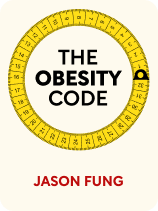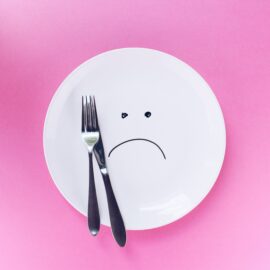

This article is an excerpt from the Shortform book guide to "The Obesity Code" by Jason Fung. Shortform has the world's best summaries and analyses of books you should be reading.
Like this article? Sign up for a free trial here .
When did calorie counting come about? Do calories matter when it comes to weight loss?
Calorie-counting as a method for monitoring weight loss has been around since the early 1900s. In the 1950s, early studies concluded that weight gain was the result of excess calories. Given this, researchers believed that dietary fat—a high-calorie food—causes weight gain.
Here’s how the “calories in, calories out” myth came about and why it’s wrong.
The Rise of Low-Fat Movement
According to Fung, the physician Jean Anthelme Brillat-Savarin first identified the fattening role of carbohydrates as early as the 18th century. At the time, sweets, breads, beers, and starches such as white potatoes were typical European foods. Decades later, Englishman William Banting echoed Brillat-Savarin’s low-carb advice: After overcoming his own obesity by eliminating starches and sugars from his diet, he advised the public to do the same. This advice held consensus through the early 1900s, when calorie counting first came about.
(Shortform note: Brillat-Savarin, not a physician but a politician and lawyer with an interest in gastronomy, is best known for writing The Physiology of Taste. In the book, which has been called “the most famous book about food ever written,” he collects witticisms, anecdotes, recipes, and reflections on the appreciation of food and eating. Given that he was a mayor rather than a scientist, it’s all the more notable that he was one of the first to identify the cause of obesity—though it’s likely he didn’t understand the nuts and bolts of the issue.)
Around the 1950s, American health professionals became concerned with rising rates of heart disease. At the time, scientists believed that dietary fat was the problem, so doctors began recommending a low-fat, high-carbohydrate diet. However, Fung says, deaths from heart disease weren’t rising dramatically due to dietary problems—rather, an increase in the efficacy of vaccines and antibiotics had decreased deaths from other killers, such as tuberculosis and pneumonia.
Nonetheless, doctors blamed dietary fat. This was because in the same decade, early studies on the effects of starvation concluded that weight gain and weight loss depend on calories, giving rise to the “calories in, calories out” myth. In this model, scientists reasoned that whatever caloric energy wasn’t used became fat, so your weight depended on how you ate (calories in) and whether you exercised (calories out).
(Shortform note: While doctors began recommending low-fat diets to treat heart disease by the 1960s, they were already popular as a weight-loss method. With the invention and availability of the home scale in the early 1900s, Americans increasingly desired to lose weight and maintain the slim figures of their youth—a desire that goes against our natural tendency to gain weight as we age. This trend continued through the 20th century into modern times. Thus, doctors adapted existing low-fat strategies, rather than creating them from scratch.)
This view on low-fat diets became orthodoxy in 1977, when the US Senate Select Committee on Nutrition and Human Needs released the “Dietary Goals for the United States.” This document made official the notion that dietary fat caused both heart disease and obesity. (Shortform note: A record of the original document is still available in archived form. While it contains the misguided recommendations Fung discusses, it also appears to recommend against eating added sugars—which he doesn’t mention, and does agree with.)
Soon followed the “food pyramid” recommendations for Americans, with floury, starchy carbohydrates as the recommended foundation for a healthy diet. Fung suggests that in the buzz about the dangers of fat, people forgot the previous consensus that refined carbs cause weight gain. As a result, the low-fat era began in earnest, with food producers creating numerous low-fat options. At the same time, government-sponsored programs under the banner of “eat less, move more” attempted to quell rising obesity, with little success.
However, some experts began to argue in the 1960s through the 1980s that low-fat, high-carb diets actually cause weight gain, not weight loss. Notably, physician Robert Atkins advocated for a high-fat, low-carb diet that seemed to promote significant weight loss. Against this medical heresy, the American Heart Association (AHA) continued to push a low-fat, high-carb diet and, Fung suggests, took money from big food producers who profited from cheap, refined, carb-based foods.
(Shortform note: Today, the AHA still recommends a protein- and carbohydrate-based diet, while suggesting low-fat or fat-free foods. In the same recommendations, they explain weight loss as a matter of calories and suggest eating less and moving more. Decades later, the AHA still uses what are, according to Fung, outdated and ineffective recommendations. Meanwhile, the diet world has expanded. Atkins-style low-carb diets are still popular, while newer options, such as paleo and veganism, explore alternative ratios of proteins, carbs, and fats.)
Not All Calories Are the Same
Traditionally, experts have reduced all foods to calories, or units of food energy, and treated calories as the most important aspect of any food. However, not all calories are the same. For instance, 100 calories of high-fructose corn syrup is quite different from 100 calories of salmon. Research supports this view, showing that different foods cause different metabolic and hormonal reactions in the body.
(Shortform note: In Salt Sugar Fat, Michael Moss says that the form a calorie comes in is what matters. Specifically, nutritionists have found that we can consume more liquid calories than solid calories before we feel full. This, Moss argues, is a key reason soda companies such as Coca-Cola became so successful—because consumers could drink multiple cans without much thought.)

———End of Preview———
Like what you just read? Read the rest of the world's best book summary and analysis of Jason Fung's "The Obesity Code" at Shortform .
Here's what you'll find in our full The Obesity Code summary :
- Why everything we were taught about obesity is wrong
- The theory of obesity as a hormonal disorder that causes overeating
- Why dieting doesn’t work and exercise actually has little impact on weight loss






